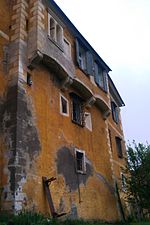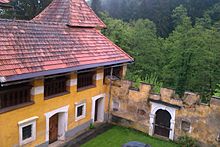Limberg Castle (Styria)
Limberg Castle is a listed castle in Limberg bei Wies in the market town of Wies in the Styrian district of Deutschlandsberg .
location
Limberg Castle is located on a hill in front of the Koralpe at 516 m. The facility is surrounded by mixed forests and is easily accessible via a road.
history
Limberg Castle was first mentioned in a document in 1244 as a castle with the name "Lindenperch", and settlement of the area is likely in the first millennium. Presumably a festival house , built by the Salzburg ministers, was the predecessor of today's castle, which dates from the 16th century. One of the main tasks of the facility at the foot of the Koralpe was to secure the transition to Carinthia. Around 1280 Limberg Castle belonged to a Hartnit von Leibnitz who sold it back to Otto Ungnad von Weißenwolf. As early as 1300 the residence was acquired by the Bishop of Seckau , who in turn sold it to the Lindenberch family. After the Lindenbergs died out in the 14th century, the Carinthian noble family of Metnitzer received the fief of the property.
From 1438 the Habsburg feudal lords, the Metnitz people kept the castle. In 1577 Andreas von Metnitz acquired a large part of the Eibiswald district court, which was moved to Limberg. Acquisitions allowed the rulership to grow rapidly, and the defense structure was rebuilt in the Renaissance style. After the death of Andreas von Metnitz in 1590, the residence changed hands several times in the 17th century, including the Count of Saurau.
In the early 18th century the castle had degenerated into a half-ruin, the property remained uncultivated for a long time. The Ortenhofen line took over Limberg Castle as the seat of power from the Jarizburgers and renovated the building. Son Johann Nepomuk Ortenhofen sold the property to Prince Johann I von und zu Liechtenstein in 1830 , whose family remained owners of the property until 1933. Then the Styrian youth welfare organization took over the castle and continued to use it as a holiday home. In 1938, Steirische Versicherungs AG bought the building and had the interior modernized.
During the Second World War , National Socialist training courses were held in the premises, and families were also allowed to use it for vacation. Bulgarians and Titopartisans occupied and plundered Limberg Castle after the end of the war, but the youth welfare service got their home back in 1948. Today the Styrian Youth Welfare Association and the scouts use it as a rest home. The last exterior renovation took place in 1960, and the palace complex was listed as a historical monument in 1977. During the Yugoslav wars in 1992/93, Limberg Castle served briefly as a refugee reception center.
Architecture and design
The structure dates from the 16th and 17th centuries. On the valley side there is a bailey with a central gate tower and two corner towers on the flanks, which are connected to the central building by galleries. The outer bailey can be reached via a baroque double free staircase that Johann Ernst Karl von Ortenhofen had built around 1725. The outer bailey is connected to the main castle via defensive walls. A moat used to run between the main castle and the outer bailey, which was spanned by a bridge. Today's access leads directly into the castle via the forecourt. Those square towers that strengthened the walls on the mountainside are hardly left.
The high castle itself is a square building with a rectangular inner courtyard with pillar arcades, which received a glass roof in 1990. Of the once splendidly furnished rooms, the knight's hall, the “painted room” and a hall in the south wing are still preserved; the stucco is from 1666 and comes from Alexander Serenio. Carved Renaissance door frames and a painted coffered ceiling are today at Hollenegg Castle in Schwanberg. The palace chapel is dedicated to Maria Immaculata , the altarpiece shows the Assumption of the Virgin and the ceiling frescoes with depictions of saints from 1722 are by Mathias von Görz.
literature
- Kurt Woisetschläger, Peter Krenn (Ed.): Dehio Steiermark (excluding Graz) . Schroll, Vienna 1982, ISBN 3-7031-0532-1 , p. 272 .
Web links
- Entry via Limberg Castle (Styria) to Burgen-Austria
Individual evidence
Coordinates: 46 ° 44 ′ 35.3 " N , 15 ° 12 ′ 37.3" E




